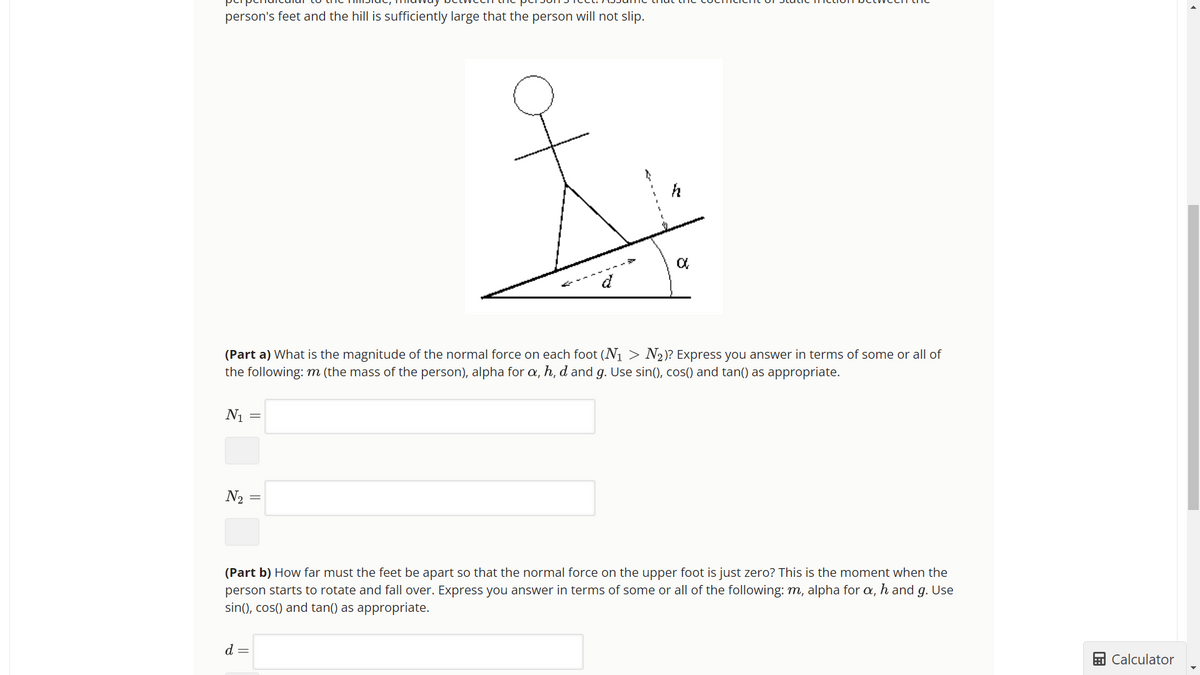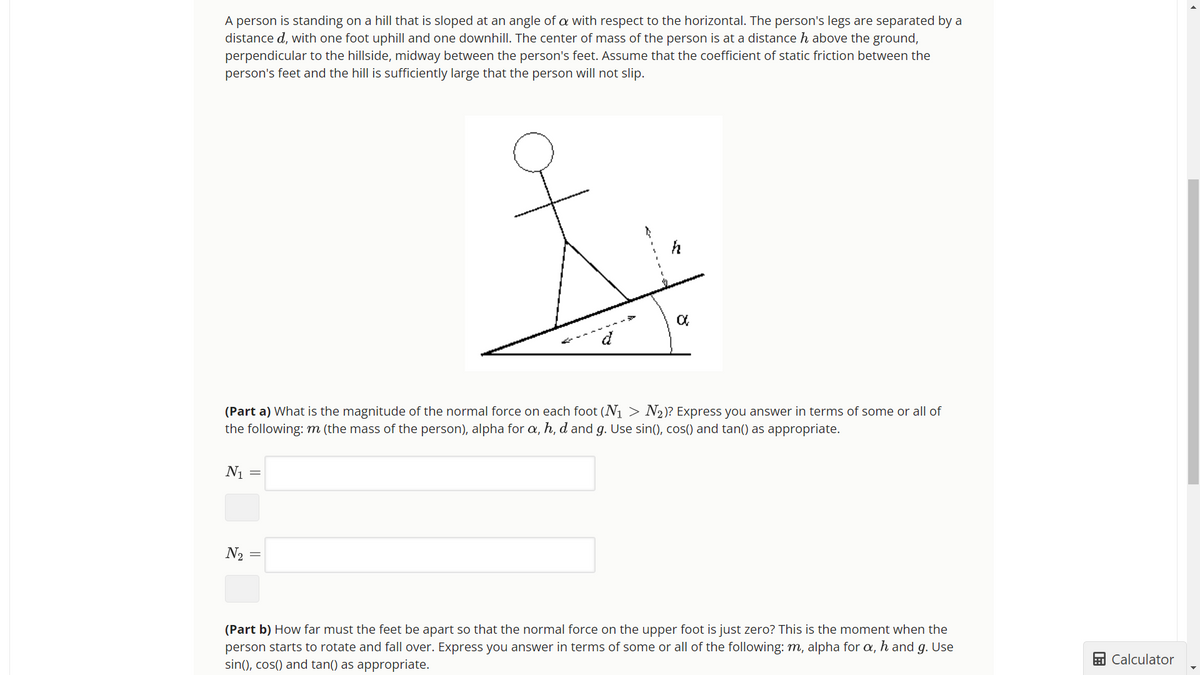A person is standing on a hill that is sloped at an angle of a with respect to the horizontal. The person's legs are separated by a distance d, with one foot uphill and one downhill. The center of mass of the person is at a distance h above the ground, perpendicular to the hillside, midway between the person's feet. Assume that the coefficient of static friction between the person's feet and the hill is sufficiently large that the person will not slip. N₁ d (Part a) What is the magnitude of the normal force on each foot (N₁ > N₂)? Express you answer in terms of some or all of the following: m (the mass of the person), alpha for a, h, d and g. Use sin(), cos() and tan() as appropriate. N₂ α (Part b) How far must the feet be apart so that the normal force on the upper foot is just zero? This is the moment when the person starts to rotate and fall over. Express you answer in terms of some or all of the following: m, alpha for a, h and g. Use sin(), cos() and tan() as appropriate.
A person is standing on a hill that is sloped at an angle of a with respect to the horizontal. The person's legs are separated by a distance d, with one foot uphill and one downhill. The center of mass of the person is at a distance h above the ground, perpendicular to the hillside, midway between the person's feet. Assume that the coefficient of static friction between the person's feet and the hill is sufficiently large that the person will not slip. N₁ d (Part a) What is the magnitude of the normal force on each foot (N₁ > N₂)? Express you answer in terms of some or all of the following: m (the mass of the person), alpha for a, h, d and g. Use sin(), cos() and tan() as appropriate. N₂ α (Part b) How far must the feet be apart so that the normal force on the upper foot is just zero? This is the moment when the person starts to rotate and fall over. Express you answer in terms of some or all of the following: m, alpha for a, h and g. Use sin(), cos() and tan() as appropriate.
Physics for Scientists and Engineers: Foundations and Connections
1st Edition
ISBN:9781133939146
Author:Katz, Debora M.
Publisher:Katz, Debora M.
Chapter14: Static Equilibrium, Elasticity, And Fracture
Section: Chapter Questions
Problem 64PQ: A One end of a metal rod of weight Fg and length L presses against a corner between a wall and the...
Related questions
Question

Transcribed Image Text:person's feet and the hill is sufficiently large that the person will not slip.
(Part a) What is the magnitude of the normal force on each foot (N₁ > N₂)? Express you answer in terms of some or all of
the following: m (the mass of the person), alpha for a, h, d and g. Use sin(), cos() and tan() as appropriate.
N₁
N₂
a
=
d =
(Part b) How far must the feet be apart so that the normal force on the upper foot is just zero? This is the moment when the
person starts to rotate and fall over. Express you answer in terms of some or all of the following: m, alpha for a, h and g. Use
sin(), cos() and tan() as appropriate.
Calculator

Transcribed Image Text:A person is standing on a hill that is sloped at an angle of a with respect to the horizontal. The person's legs are separated by a
distance d, with one foot uphill and one downhill. The center of mass of the person is at a distance ʼn above the ground,
perpendicular to the hillside, midway between the person's feet. Assume that the coefficient of static friction between the
person's feet and the hill is sufficiently large that the person will not slip.
(Part a) What is the magnitude of the normal force on each foot (N₁ > N₂)? Express you answer in terms of some or all of
the following: m (the mass of the person), alpha for a, h, d and g. Use sin(), cos() and tan() as appropriate.
N₁
N₂
a
=
(Part b) How far must the feet be apart so that the normal force on the upper foot is just zero? This is the moment when the
person starts to rotate and fall over. Express you answer in terms of some or all of the following: m, alpha for a, h and g. Use
sin(), cos() and tan() as appropriate.
Calculator
Expert Solution
This question has been solved!
Explore an expertly crafted, step-by-step solution for a thorough understanding of key concepts.
This is a popular solution!
Trending now
This is a popular solution!
Step by step
Solved in 4 steps with 4 images

Knowledge Booster
Learn more about
Need a deep-dive on the concept behind this application? Look no further. Learn more about this topic, physics and related others by exploring similar questions and additional content below.Recommended textbooks for you

Physics for Scientists and Engineers: Foundations…
Physics
ISBN:
9781133939146
Author:
Katz, Debora M.
Publisher:
Cengage Learning

Physics for Scientists and Engineers: Foundations…
Physics
ISBN:
9781133939146
Author:
Katz, Debora M.
Publisher:
Cengage Learning